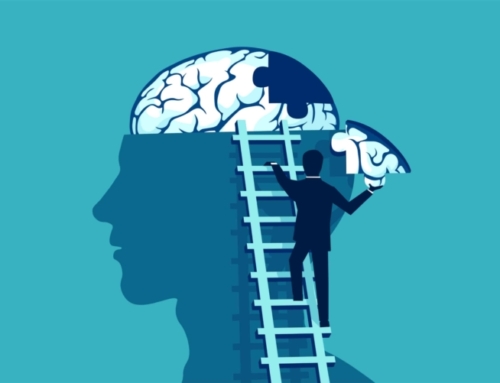A lot of our suffering is self-induced and occurs from our perception of personal shortcomings. It’s easy to be disappointed in ourselves, especially given how competitive, fast-paced, and media-laced life is these days, and how high our expectations for ourselves have become. After all, anyone reading this is in a self-selected group of high-achieving individuals. It’s easy to look at our undeniable successes and see the glass as half-full. The tendency is to contemplate all that we’re missing out on and what more we could be. We feel we could accomplish more if only … if only we were better somehow.
Also, not only can we be disappointed by a shortcoming, by some missing part that we need to lead to even greater success, but also disappointed by a part of ourselves that is very much present, but one that is ugly, embarrassing, scary, or even disgusting to ourselves.
Starting in childhood, we begin developing an image of ourselves that we present both to the world and to ourselves. Often this self-image is of an ideal self, one whose attributes are shaped by family expectations, social learning, media, and one’s own temperament, interests, experiences, and expectations. This ideal self is comprised of all the right parts and the absence of all the wrong parts. Pretty soon our self-concept becomes narrow and rigid and insists on including desired parts that don’t exist while excluding unwanted parts that do exist. In other words, our ideal self is a fiction.
Under certain circumstances, an ideal self can spur us towards positive action, providing the motivation to reach for something more and to be better for it. Under many other circumstances, that ideal self becomes a reason for chronic self-disappointment, self-opprobrium, stress, and maladaptive emotional regulation strategies.
So, here is my thought for you: the easiest way to like yourself more is to realize that your constructed ideal self is fiction and causes you pain. The ideal self is not realistic, based as it is on having all the right pieces and none of the wrong pieces. We are all simply too complex, with multitudes of parts, for this ideal self to ever be achieved.
The concept of the multi-mind (Robert Ornstein, 1986) can cure you of a narrow ideal self-concept. Deep down, none of us are one person. Yes, we have one body and we usually think one thought at a time. But our brains have so many circuits that our thoughts and emotions change tracks from one moment to another. We are the integration of multiple brain processing units.
We have this false sense of being a single integrated entity because 1) we consciously experience a linear series of thoughts and 2) it feels like we choose and direct them. We don’t. Right now stop and attend to your thoughts. Where do they come from? Are you choosing them? You’ll quickly realize that your thoughts simply arise into consciousness. You are an observer of them. It’s more accurate to say that your thoughts have you than to say you have your thoughts.
So, if we do not control our thoughts, how do they arise and progress from one to another? The Global Neuronal Workspace (GNW) Model of Conscious Access (Dehaene et al, 2011) proposes that “associative perceptual, motor, attention, memory and value [brain] areas interconnect to form a higher-level unified space where information is broadly shared,” becoming available to consciousness. What this means is that our brains have different processors working outside of consciousness that integrate their inputs. It’s like a committee comprised of several members, each with their own area of expertise and vested interest. These member processors “argue and shout” behind closed doors, trying to sway the outcome to the one that best meets their needs. The outcome of this rambunctious processing is the “amplification and global broadcasting, to many distant [brain] areas, of a single piece of information selected for its salience or relevance to current goals.” This outcome, dear reader, is your next thought. And on it goes through every waking moment.
What gives me a sense of greater understanding of myself and acceptance is to realize that, yes, I’m one person in one body, but internally I am a multitude, a family of rambunctious parts, each vying to be noticed and to affect the outcome. This point of view isn’t necessarily incompatible with the concept of an ideal self, but it does soften it. It’s hard for me to ever view myself as, first, having static parts that I just need to organize correctly and, second, that I’m comprised of only all the right parts and none of the wrong parts. Further, the GNW Model makes “right” and “wrong” parts a silly concept. It’s clear that only one part of me is judging the “rightness” and “wrongness” of all of me. No wonder the other parts of me rebel! One loud or aggressive member of my internal committee (or family) has imposed his will on all the other members – that is, on all of me.
So, what do I now believe: that I am an amalgam, that I have all kinds of parts, that there is no reason to think they all move in lock-step towards one right goal or to self-assemble into one ideal social self. I expect dissent and change and friction. I expect to desire incompatible things, to change my mind about what I believe about myself and the world, to know that the rightness or wrongness of my goals and desires is subjective (within limits), to feel tension with myself and feel I’m often working at cross-purposes. I’m just one big loud internal family, with all the good and the bad, all the ease and difficulty, with all the joy and irritation one experiences in a family.
Let me address two possible concerns. First, does the multi-mind perspective kill one’s motivation to reach one’s goals? No. For me, the multi-mind perspective allows me to be flexible. I still have desires and goals and my progress is – if anything – faster in reaching them. I don’t spend time thinking about myself and what is ideal or not. I just keep on moving, moving towards what seems salient and right and good. It has removed a whole area of concern from my mind, of self-induced suffering.
And two, does the multi-mind perspective lead to accepting all one’s shortcomings and kill striving to be a better person? No. I continue to assess and improve my behavior. I want to be a kinder and more effective person, to build new skills, etc. But regarding my “self,” I rarely think about it and when I do, I am more accepting of it because it’s private and I expect it to be messy. I know my thoughts are only indirectly under my control. They come and go. I notice the interesting ones and jot them down – I’m always writing something – and I just let the other ones pass by – Hello-Goodbye! I can be non-reactive toward them because I know my internal family is always up to something, whether it’s something wise or foolish. What a kaleidoscope every moment can be!
Thanks for reading,
Dr. Jack
LanguageBrief
“If you’re not confused, you’re not paying attention.” – Tom Peters
“The ideal art, the noblest of art: working with the complexities of life, refusing to simplify, to ‘overcome’ doubt.” – Joyce Carol Oates
“Acceptance doesn’t mean resignation; it means that something is the way it is and that there’s got to be a way through it.” – Michael J. Fox
“The most terrifying thing is to accept oneself completely.” ― C.G. Jung







Leave A Comment